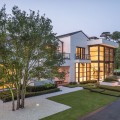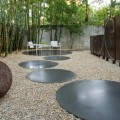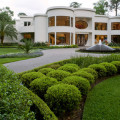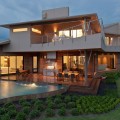Contemporary Front Yard Design

Contemporary front yard design tends to be more customized to home architecture than other forms of landscaping design.
This is because contemporary homes typically emphasize the abstract side of the mind with the use of very basic geometric forms, minimalism, and linear angularity that suggests a stripping down of reality to its most rudimentary components. Front yards surrounding such homes must reflect the patterns and lines of movement evident in home design in order to maintain continuity with the strong emphasis on Mentalism characteristic of all contemporary design and art.
Unlike most landscapes that emphasize the beauty of nature and exterior structures, contemporary front yard landscaping specifically focuses on supporting the proportions and aesthetics of the house. Nature is used as a backdrop to the design build of human dwelling and structural achievement. This is deliberate in order to emphasize Man’s unique position in Nature as a being who is able to shape his environment on a conceptual level alone without having to remain within the boundaries of what we typically consider to be the concrete forms of Nature. This is often done to emphasize the mind’s ability to alter reality without restriction on inner perception. This is also why we often see contemporary art take a basic geometric shape, such as a quadrilateral, deliberately distort its dimensions, and then combine it with one or more other forms to extend its essence into multi-dimensional space to represent Man’s sense of destiny as an explorer of the Unknown.
The intent of most contemporary homes is to project such a mindset that is also highly personalized to the homeowner. Eclecticism is the rule here, not the exception to the rule. Many owners of such homes work in the architectural, design, or fine arts community themselves. Their houses are deliberate expressions of both their personal lifestyles and their professions. This leaves little room, in most cases, for an exploration of the beauty of Nature as a realm in its own right. Natural forms that are useful to humanity are reshaped into new forms that reflect aspects of human thought and unconscious forces of emotions. Front yard design in such an environment will often lack the typical emphasis on foliage we seen in traditional landscapes. Instead, it will act more like a natural frame for an obviously human form that centers the landscape on a sense of evolutionary preeminence.
In this sense, organic elements are completely subservient to human design and tend to exist in contemporary front yards only as supportive elements for the home, outdoor decorative sculpture, exterior buildings, and modernesque hardscapes, seating areas, and pathways. Gravel, concrete, and rock tend to constitute the majority of design elements here, with vegetation being used to establish linear direction or a sense of perimeter around an entertainment area, special interest point, decorative element, or abstract art form.
Gardens are highly minimalist in contemporary front yards and typically evidence a stark deviation from typical garden design patterns. This is not to say that tradition is completely thrown out the window when installing a garden in front of a contemporary home. However, traditional forms that emphasize natural beauty are either significantly altered or combined into new forms in much the same way that home architecture uses both the distortion and combination of basic geometric shapes to create new designs rooted in the abstract realm above and beyond concrete reality.
Examples of contemporary front yards can be seen in some of the case studies published in our Landscaping Portfolio. Each of these examples shows a high level of customization and evidences the points we have made in this essay regarding the subservient purposes of landscaping to contemporary architecture and living experience and a de-emphasis on what we typically idealize as the beauty of Nature as a realm of experience to be enjoyed in its own right.




